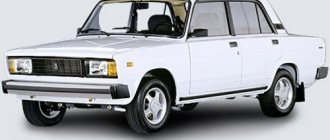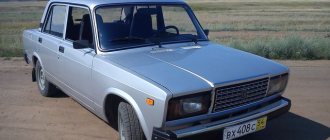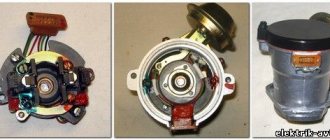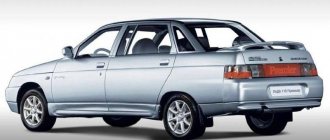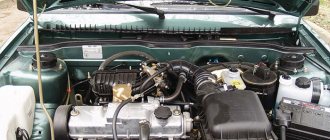The VAZ-2113 car was created in 2004 on the basis of Sputnik, the first Soviet front-wheel drive model VAZ-2108, popularly known as the “eight” and “chisel”. The car under the symbol 2108 belonged to the small class II group of cars produced by the Volzhsky plant and was produced from 1984 to 2003. The model was exported under the name "Lada-Samara". The new VAZ-2113 car was produced until 2013; a total of 72,359 cars rolled off the assembly line. European countries have always been open to an inexpensive model with good performance. The car was not supplied to the US and Canadian markets.
The VAZ-2113 became a technical replacement for the G8, its restyled version. Production of the updated model began after the launch of the Samara-2 project, which was focused on creating a car that was fundamentally different from the usual developments of the VAZ family, made on the basis of a license from the Italian Fiat. The project was a success, and Samara took its place in the new generation lineup.
Among other models
The front-wheel drive of the VAZ-2113 model was its main difference from the cars of the VAZ model range: the 01st “kopek”, the spacious VAZ-2102 station wagon, the reliable VAZ-2103, the stylish “six” and the representative of modern exterior forms, the VAZ-21043. The technical advantage of the machine was obvious in some other respects.
Since the VAZ-2113, a new model, was formally considered a repetition of the G8, the design bureau of the Volzhsky Automobile Plant adhered to all the parameters of the VAZ-2108. However, during the production that began, it was necessary to deviate from the established technological processes. This was due to the need for changes in the exterior of the new car, since direct copying of the contours, tail shape and other components was not allowed. What was needed were visual signs of new forms of the car, which was positioned as an independent model with a full set of individual technical characteristics.
Exterior
The front of the VAZ-2113 has changed radically; the simple rectangular block headlights that were on the V8 were abolished - they were replaced by stylish, horizontally elongated optics with an integrated yellow turn signal light. Combining several functions under one glass does not always benefit the appearance of the car, but in this case the decision was successful. The headlights of the VAZ-2113 organically fit into the tip of the front wings and hood. The lower bumper continued the panel of the engine compartment; an elegant strip ran across its entire surface, encircling the perimeter of the car. The doors are distinguished by a discreet, noble design; their lower part smoothly merges into the sill fairings.
Aerodynamics
The rear part of the “thirteenth” model passed from the VAZ-2108 practically unchanged, with the exception of the bumper and spoiler borrowed from the 2114 model. The slightly modified shape of the doors made it easier for passengers to enter, which previously caused many problems. New front fenders, a streamlined hood, an integrated bumper and organically integrated optics made the VAZ-2113 model exemplary in terms of aerodynamic qualities.
The car fit perfectly into the oncoming air flow, and the rear spoiler pressed it to the road surface, thereby ensuring good stability at any speed. The low body profile and relatively low ground clearance contributed to confident cornering. The car is characterized by a complete absence of rocking effect and never “scours” on the road, the ride is smooth.
VAZ-2115
A four-door modification that replaced the VAZ 21099. The VAZ-2115 became the first modification in the line of restyled cars of the family. Pilot production of the modified “99th” began back in 1997. The VAZ 2115 is equipped with a new trunk lid, front and rear optics, body-color bumpers, a trunk spoiler, side skirts and a number of innovations in the interior and electrical equipment.
VAZ-2115
The suspension, transmission and braking system are borrowed from models of the 2108 family, although their modernization was initially planned. The angular shapes in the exterior are a thing of the past. By lowering the rear edge of the trunk, loading things has become noticeably more convenient.
Particular attention was paid to improving electrical equipment. The equipment included: power windows for the front doors, PTF, and new headlights. In the luxury version, the car is even equipped with heated front seats. A trip computer that allows you to monitor the condition of the lamps, oil level, brake pad wear, and the level of coolant and washer fluids is included in any package.
VAZ-2115
From 1997 to 2000, the 2114 was equipped with VAZ-21083 carburetor engines with a displacement of 1.5 liters and a power of 71.6 liters. With. Since 2000, with the start of mass production, this power unit was replaced by a VAZ-2111 engine with distributed fuel injection. The volume remained the same, but the power increased to 77.8 liters. With. Since 2008, they stopped installing the VAZ-2111 engine, replacing it with the more advanced VAZ-11183, with a volume of 1.6 liters and a power of 80.9 hp. With.
Production of the VAZ-21099 continued until 2004, and then the old model was discontinued, completely replacing the “fifteenth”.
In 2008, the VAZ-2115 underwent minor changes, affecting mainly the exterior.
Chassis
The front suspension of the “thirteenth” model is an independent wishbone with a transverse stabilizer. Hydraulic shock absorbers combined with coil springs. The rotating axle is secured by means of two ball joints, upper and lower. The mechanism is connected to the rack and pinion steering. Rotation is transmitted to the front wheels using a constant velocity joint (CV joint), connected to the engine by two axle shafts through a gearbox.
The rear suspension is pendulum semi-independent, equipped with a transverse stability beam. Reverse action hydraulic shock absorbers are combined with reinforced coil springs. Initially, the model was produced with a conventional spring-shock absorber set, but during operation, an insufficient coefficient of helix resistance was revealed, and the rear suspension had to be strengthened.
The car's braking system is dual-circuit diagonal, with a vacuum booster. Pressure is supplied from the central cylinder. The front brakes are disc, non-ventilated. The rear ones are drum type with automatic clearance adjustment.
Chassis, transmission and engine
As for the chassis, the “thirteen” offers a MacPherson strut suspension similar to the “eight” at the front and a torsion beam at the rear, as well as front disc and rear drum brakes. The gearbox is exclusively mechanical, with 5 speeds, regardless of the configuration.
Chassis VAZ-2113
The range of power plants is represented exclusively by gasoline engines with distributed injection. In total, 5 types of engines were installed on the trinashka:
- VAZ-2111. Four-cylinder unit, volume 1.5 l (1499 cm³), power 77 hp. at 5400 rpm. Found on the first basic models from 2004-2007.
- VAZ-21114. Four-cylinder engine with a volume of 1.6 liters (1596 cm³), power of 82 horses at 5200 rpm. It is standard on assembly models from 2007-2011.
- VAZ-11183. Four-cylinder 82-horsepower engine with a volume of 1.6 liters (1596 cm³). It is available in luxury and standard trim levels, which were released from 2011 to 2013.
It is worth noting that the thirteenth models of the “Samara” family were equipped with two more types of engines:
- VAZ-21124. The engine has 4 cylinders and 16 valves, a volume of 1.6 liters (1599 cm³) and a power of 89 horses. The unit was installed on models with the “norm” configuration, produced from 2010 to 2013.
- VAZ-21126. Four-cylinder engine, volume 1.6 liters (1597 cm3), power 97 hp. With. Found on some models, produced in 2010-2013, in the “Standard” configuration.
These engines were installed on Ladas of Samara, but not produced by VAZ, but by the company of AvtoVAZ’s subsidiary, Super-Avto CJSC. This enterprise, also based in the city of Tolyatti, next to the Volzhsky Automobile Plant, and since 1997, has been producing modifications of Lada models to order from the parent company, including analogues of the 2113. By the way, on such hatchbacks, on the back of the trunk door, under the Lada branding ”, there is an inscription - SUPER-AVTO.
Engine VAZ-2113
Trinashka engines are quite simple in design, unpretentious in maintenance and have excellent maintainability. If you have the desire, as well as the Internet to search for the necessary information, even a beginner can handle the repair of these units.
Interior
Thus, the parameters of the VAZ-2113 were revised towards updating. The “thirteenth” model received a more modern exterior design, as well as a radically changed interior.
The interior of the car was noticeably updated with the installation of a new dashboard of the “European panel” type, which differed from the previous one in a number of features: the glare that previously annoyed the driver disappeared, instrument indicators, arrows and digital symbols became better readable, the gasoline level and coolant temperature sensors were changed your shape for the better. The dashboard lighting has become softer and more diffused, which has a relaxing effect on the driver and passengers. The ceiling lamps were turned on remotely using a toggle switch on the center console.
The steering was modernized, the column became adjustable, its tilt was 12 degrees. This was enough to select the optimal position taking into account the driver’s height. The steering wheel rose and fell in a vertical plane within 80 millimeters.
The seats in the first row have changed shape, the cushions have become deeper at the junction with the backrest, and the backrests have been extended. The changes have added ergonomics to the seats and increased the overall comfort level of the car interior. The rear seat and backrest remained unchanged - their parameters did not need improvement. The lower part of the sofa easily rose, providing access to the fuel tank, and the raised back made it possible to communicate with the luggage compartment directly from the car's interior.
Technical features of the VAZ 2113
The “Thirteenth Model” and its modifications are produced in the same body, but with modified hinged panels, such as the trunk lid, fenders, hood and others.
The interior, compared to the first front-wheel drive family, has changed quite a lot - panels, ceilings, door cards, dashboard and instruments themselves - all of this has been modernized for installation in the new model.
The VAZ 2113 engine was initially installed the same as on the 2108 - an eight-valve transverse engine with a distributed injection system. In 2007, engine capacity increased to 1.6 liters. When equipped with a new engine, the car complies with Euro-3 standards.
In 2010, a limited number of models of the family began to be equipped with a sixteen-valve VAZ-21124 engine with a power of 90 hp from the VAZ 2110 and a forced VAZ-21126 (98 hp) from the LADA Priora. With these engines, the car's rated maximum speed is 185 kilometers per hour.
Options
The VAZ-2113 model is supplied to the market in three versions: “Norma”, “Standard” and “Lux”. Standard equipment includes a heated rear window wiper, immobilizer, CO2 catalyst, on-board monitoring system, and adjustable steering column. The “Norma” set is practically the same as the “Standard” set with minor additions. The “Lux” package contains everything that is included in the first two sets, plus rear seat headrests, an on-board computer, athermal glass, and fog lights.
Specifications Features
If the body received minor changes, then the engine was seriously modernized. In the first VAZ 2113 models, a power unit from the Lada 2111 was installed - an injection unit with a displacement of 1550 cubic meters. cm. It had a distributed injection system and was practically no different from a carburetor engine; its power was 77 hp. With. Such engines were unpretentious and reliable, but far from perfect. Since 2007, models of the Samara 2 family began to be equipped with a new engine with the index 11183. Its volume is 1.6 liters and the rated power is 82 hp. With. It meets Euro-3 safety standards and regulations. The main distinguishing feature is the presence of a catalyst, which began to be installed in the engine compartment, and not under the bottom. Average fuel consumption ranges from 6.5 to 8 liters per 100 kilometers in the combined cycle.
The VAZ with index 2113 has a fuel tank with a volume of 43 liters. Under the hood you can see a plastic receiver - previously it was aluminum. The latest modification is equipped with an updated 1.6-liter engine. This 16-valve engine produces 89 hp. With. Some changes have been made to the transmission and clutch. Since 2007, an electronic gas pedal has also been installed. In 2010, a limited and last modification of the serial production VAZ 2113 was released. Under the hood, a 16-valve engine from Priora with a rated power of 98 hp was installed. With. The car received a significant increase in dynamic characteristics. The car was produced in various shades, there were about 150 in total. Of these, the most popular were “Quartz” and “Perseus”.
The main idea of creating a compact hatchback is dynamism and good suspension. The braking system is classic, with front disc brakes and drums installed at the rear. The front suspension has a MacPherson strut - independent with wishbones. The rear is semi-independent with a torsion longitudinal beam, springs and shock absorbers. The steering uses a rack and pinion, there is no power assist.
The transmission used is only a manual gearbox, which has no fundamental differences from the gearbox of other VAZ cars of the 10th family.
The car was supplied in three main trim levels: “Standard”, “Norma” and “Lux”. Each of them had its own characteristics. The basic package includes an immobilizer, rear window washer and heating, steering wheel height adjustment, and on-board control. The “Lux” added an athermal windshield, fog lights, powerful sound signals, head restraints for rear passengers, an on-board computer, and side mirrors with anti-reflective coating. Power steering, anti-lock braking system and air conditioning have never been installed on the VAZ 2113.
VAZ 2113 is one of the most convenient cars in terms of tuning and modifications. The main advantages are low cost and inexpensive spare parts. Like the legendary G8, the VAZ 2113 also became a real youth car with a sporty character. The car has already been discontinued, but will remain popular on the secondary market for a long time, so it will not disappear from the roads for many years.
Tuning VAZ-2113
It is usually customary to tune cars from the distant past. However, the VAZ-2113 model, being quite modern, involves radical changes in appearance in order to be able to change the image, as well as give the owner a chance to show his creative abilities. You can realize your plans if you have the technical equipment. Tuning a VAZ-2113 is, in any case, a fascinating creative process using modern technologies. The result depends on many factors, but can be impressive.
VAZ 2113: History of creation
This car is an advanced analogue of the famous VAZ-2108 car, which at one time became a real mainstream of the Soviet automobile industry. The G8, released in 1984, became not only one of the first front-wheel drive Soviet cars, only the LUAZ-969V appeared before it, produced by the Lutsk Automobile Plant from 1966 to 2002 and an innovative model for its time.
It was with the G8 that a completely new era began for VAZ cars, which finally abandoned copying Fiat models and created a product with its own design and interior.
Actually, the exterior was developed by VAZ specialists - Vladislav Pashko and Viktor Kryazhev, under the leadership of chief designer Mark Demidovtsev. The interior was created by Vladimir Guba, a VAZ employee who completed an internship in Germany at the plant of the world famous company Porsche.
VAZ-2113 – front view
It was the G8 that became the first-born in the long-lived dynasty of Lada Samara cars. This family includes model 2109, the same hatch, but a five-door, the series of which started in 1987, as well as the most prestigious Russian sedan of the 90s - Lada Samara 21099. At the beginning of the 2000s, the entire line was restyled and, accordingly, each model of the family acquired a new index in the name.
Thus, the updated version 2108 received the index 2113, that is, the model that we are considering in this article.
In fact, the VAZ-2113 is not a full-fledged generation change of the G8, but only its restyling on the previous platform - Gamma.
Simply put, the developers largely retained the body contours of the G8, but still carried out a fairly extensive upgrade to the exterior. In addition, they modernized the interior, modernized the engine equipment, completely replacing the carburetor internal combustion engines with more advanced injection engines.
